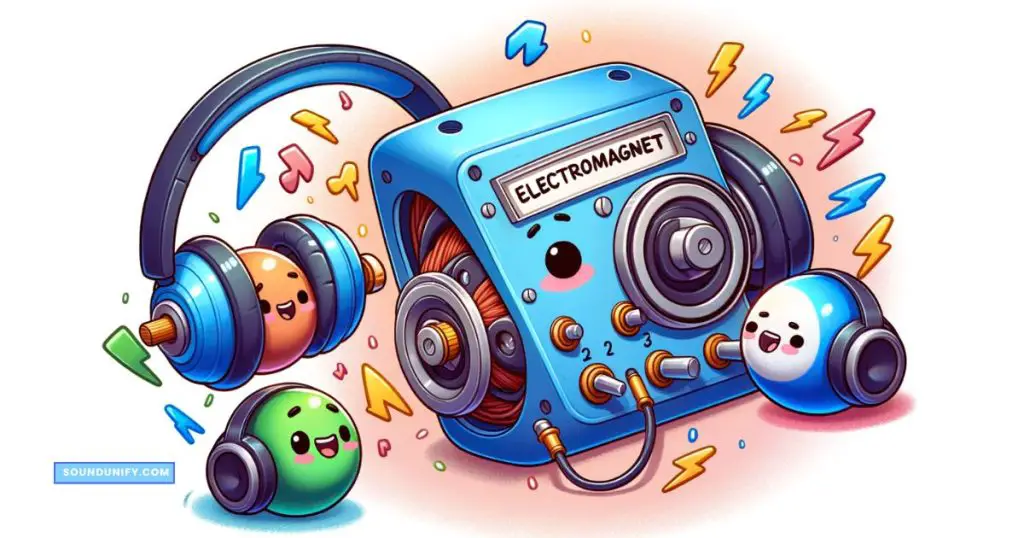Headphones are not just about music; they're a marvel of electromagnetism at play. How do headphones use electromagnets to bring your favorite beats to life?
Imagine this: inside each headphone, a tiny electromagnet is hard at work. When you hit play, electrical signals from your device travel through the wires and meet this electromagnet.
This meeting isn’t a quiet affair; it’s a dynamic dance where electrical currents and magnetic fields tango, creating vibrations. These vibrations are the heartbeats of the sound you love.
It’s a magical world where science meets art. As a tech enthusiast, I am mesmerized by this blend of physics and music. So, are you ready to dive deeper and discover the hidden concert within your headphones? Let’s unravel this symphony of electromagnetism together.
What is an Electromagnet?

An electromagnet is a magnet that uses electric current to create a magnetic field. It can be turned on and off, controlling the magnetic field.
Electromagnets are used in various applications, such as headphones, speakers, and electric motors.
The strength of an electromagnet depends on the number of turns in the coil and the amount of current flowing through it.
Components of an Electromagnet:
The components of an electromagnet are critical to its function and design. These components include:
- Coil or Solenoid: The coil, often a solenoid, is a crucial component. It’s made from an electrically conductive wire, usually, copper, wound into a series of loops. The number of turns in the coil directly impacts the strength of the magnetic field generated. An electric current that passes through this coil creates a magnetic field.
- Core Material: Inside the coil, there’s usually a core material, which is typically made of a ferromagnetic material like iron, cobalt, or nickel. This core material enhances the magnetic field produced by the coil. The ferromagnetic core becomes magnetized when the current flows, significantly increasing the strength of the magnetic field compared to the coil alone.
- Electrical Energy Source: An electromagnet requires a source of electrical energy to produce a magnetic field. This could be a direct current (DC) power supply, a battery, or any other source of electrical current. The strength of the magnetic field is proportional to the amount of current flowing through the coil.
- Switch or Control Mechanism: A switch or other control mechanism is included to control the electromagnet. This allows the electromagnet to be turned on or off by controlling the flow of electricity through the coil. In some applications, this control mechanism can also vary the amount of current and, thus, the strength of the magnetic field.
- Insulation: The wire in the coil is usually insulated to prevent short circuits. Insulation ensures that the electric current flows along the wire and does not leak to other parts of the electromagnet or the environment.
- Heat Dissipation Elements: Electromagnets can generate significant heat due to the wire’s electrical resistance in the coil. Therefore, heat dissipation elements like heat sinks or cooling systems may be incorporated, especially in high-power applications, to manage and disperse the heat generated.
These components allow electromagnets to function effectively and safely in various applications, from small-scale devices like headphones and speakers to large-scale industrial machinery.
The Science Behind Electromagnets in Headphones

Electromagnets in headphones play a massive role in sound production, converting electrical audio signals into mechanical wave energy.
This process, known as electromagnetic induction, involves the interaction between electrical signals and the magnetic structure of the headphones.
The resulting mechanical vibrations of the diaphragm are induced by the pressure variations created by the magnetic field. Magnets play a crucial role in the transducer component of headphones.
Here’s how it works:
- Electromagnetic Induction: The fundamental principle at play is electromagnetic induction, which involves the generation of an electric current or electromagnetic force through a magnetic field. This is the same principle that underlies the functioning of transformers, electric motors, and generators.
- Components of the Headphone Electromagnet: In headphones, the electromagnet typically comprises a voice coil (a type of solenoid) and a permanent magnet. The voice coil, made from a coil of wire, is attached to the headphones’ diaphragm.
- Creation of Sound Waves: When audio signals (electric current) are sent through the voice coil, a varying magnetic field that interacts with the field of the permanent magnet is created. This interaction causes the voice coil and the attached diaphragm to move back and forth.
- Vibration and Sound Production: The movement of the diaphragm due to the electromagnetic force pushes and pulls air, creating sound waves. The frequency and amplitude of these sound waves correspond to the original audio signal, thus producing the sound you hear.
- Control of Sound Quality: The quality of sound produced in headphones depends on several factors, including the strength of the magnets, the number of turns in the voice coil, and the materials used in the diaphragm. Manufacturers tweak these variables to enhance sound quality, bass response, and clarity.
- Advantages of Electromagnets in Headphones: Electromagnets are preferred in headphone design for their precision in converting electrical signals to sound and ability to produce a wide range of frequencies and dynamic sounds.
This system is elegant in its simplicity yet complex in its execution, balancing physical laws with audio engineering to create a pleasing auditory experience.
Whether in tiny earbuds or over-ear headphones, using electromagnets is crucial for delivering high-quality sound directly to the listener’s ears.
Role of Magnets in Headphone Design

In headphone design, magnets are essential as part of the transducer, the device responsible for converting electrical energy (audio signals) into mechanical energy (sound waves).
Typically, headphones employ permanent magnets made from materials like neodymium or ferrite. Neodymium, in particular, is favored for its combination of lightweight properties and high magnetic strength, crucial for enhancing portability and comfort in headphone use.
These magnets work in tandem with a voice coil, a wire coil that creates a varying magnetic field when an audio signal passes through it. The interplay between this magnetic field and the one from the permanent magnet leads to the movement of the diaphragm, a thin, flexible piece attached to the voice coil.
The quality of sound reproduction hinges significantly on this mechanism—the magnet’s strength determines the responsiveness of the voice coil and, thus, the clarity and precision of the sound.
In noise-cancelling headphones, magnets assume an even more critical role. They help create sound waves that negate ambient noise, allowing for a more immersive listening experience.
Furthermore, modern magnets‘ durability and compact size, especially neodymium, enable the production of smaller, more comfortable headphones without sacrificing sound quality.
This balance of size, durability, and performance highlights the indispensable role of magnets in headphone technology.
How Different Headphones Utilize Electromagnets?
Different headphones fundamentally rely on electromagnets to produce sound despite their varied designs and intended uses.
This core mechanism is consistent across various styles, from over-ear to in-ear models. Here’s how electromagnets are utilized in different types of headphones:
- Over-Ear and On-Ear Headphones: In over-ear and on-ear headphones, electromagnets are used in a larger format than other types. These headphones typically have more significant drivers, which means larger voice coils and magnets. This allows for a broader dynamic range and the ability to produce deeper bass and more transparent highs. The larger size of these headphones accommodates these bigger electromagnets, contributing to their enhanced sound quality.
- In-Ear Headphones (Earbuds): Despite their small size, in-ear headphones also utilize electromagnets. Due to space constraints, the electromagnets in these headphones are much smaller. While this might limit the dynamic range compared to larger headphones, advancements in material science and design have allowed for impressive sound quality even in these compact devices. The miniaturized voice coils and magnets in in-ear headphones are precisely engineered to provide a balanced and clear sound.
- Wireless Headphones: Wireless headphones, regardless of their form (over-ear, on-ear, or in-ear), include electromagnets in their sound-producing drivers. The primary difference is the inclusion of battery-powered circuits to receive and decode the Bluetooth audio signal. The decoded electrical signal is then sent to the voice coil, functioning like wired headphones.
- Noise-Cancelling Headphones: In active noise-canceling (ANC) headphones, electromagnets are used for sound production and as part of the noise-cancellation process. These headphones use additional microphones that pick up external noise and circuitry to create a sound wave that is the opposite (anti-phase) of this noise. The electromagnets in the drivers then produce these anti-phase sound waves, effectively canceling out ambient noise.
- Sports and Gaming Headphones: In sports headphones, durability and resistance to elements like sweat are essential, but the core technology of using electromagnets for sound production remains the same. In gaming headphones, electromagnets are often tuned for enhanced bass and spatial effects to provide a more immersive gaming experience. Additionally, gaming headphones might have more complex electromagnet setups for multi-driver configurations, offering surround sound or 3D audio effects.
Can Headphones Work Without Magnets?
Headphones, as traditionally designed, cannot work without magnets. Magnets are fundamental in how most headphones convert electrical signals into sound. The typical headphone design uses a dynamic driver with a voice coil and a magnet.
When an electrical signal passes through the voice coil, it interacts with the magnetic field, causing the coil (and attached diaphragm) to move, thus producing sound.
However, there are alternative technologies for sound reproduction that don’t rely on conventional magnets:
- Planar Magnetic Headphones: These use a different approach but involve magnetic fields. Planar magnetic headphones have a thin, flat membrane between magnets. Audio signals pass through this membrane and interact with the magnetic field to produce sound. While these still use magnets, the mechanism differs from traditional dynamic drivers.
- Electrostatic Headphones: These do not use magnets. Instead, a thin, electrically charged diaphragm is placed between two conductive plates. When audio signals are applied to these plates, they create an electrostatic field that moves the diaphragm, thus producing sound. Electrostatic headphones are known for their precision and clarity but are expensive and require special amplifiers.
- Bone Conduction Headphones: These do not rely on air-conduction (like traditional headphones) or magnets in the conventional sense. Instead, they use vibrations conducted through the bones of the skull to stimulate the inner ear directly. This technology benefits people with certain hearing impairment types and situations where environmental sound awareness is essential.
- Piezoelectric Headphones use piezoelectric crystals that change shape when an electrical current is applied. This shape change produces sound. While not common in consumer headphones, piezoelectric technology is another method of making sound without conventional magnets.
Each alternative to traditional magnetic headphones has its characteristics, advantages, and drawbacks. They cater to specific needs and preferences, from high-fidelity audio reproduction to unique listening circumstances.
However, magnet-based headphones remain the standard for the mainstream market due to their cost, efficiency, and quality balance.
FAQs
What is the use of magnets in headphones?
The headphone magnet creates a magnetic field that interacts with the audio signal, allowing for sound production. The strength of the magnet impacts the quality and volume of the sound. Different headphone designs utilize various types of magnets, such as neodymium or ferrite magnets.
What does electromagnetism do for sound?
Electromagnetism plays a crucial role in sound production for headphones. Electromagnets create the sound waves we hear by converting electrical signals into vibrations. This allows for greater control and precision in the movement of the headphone diaphragm, resulting in more precise sound quality. Additionally, electromagnets enable more efficient energy use, contributing to longer battery life in wireless headphones.
What audio devices use electromagnetism?
Audio devices that utilize electromagnetism include headphones, speakers, electric guitars, microphones, magnetic tape recorders, hard drives, and medical devices like MRI machines. These devices use electromagnetism to convert electrical signals into sound waves or vice versa for recording and playback purposes.
Do loudspeakers use electromagnets?
Yes, loudspeakers utilize electromagnets to generate sound. The voice coil, an electromagnet in the loudspeaker, interacts with a permanent magnet when an electric current passes through it. This interaction moves the speaker cone, producing sound waves. The sound’s quality and volume depend on the electromagnet’s size and strength.
How Do I Know If My Headphones Are Using Electromagnets?
You can check their specifications or manual to determine if your headphones use electromagnets. Typically, headphones with dynamic drivers utilize electromagnets. These headphones often deliver high-quality sound and impressive bass response.
Do all headphones have magnets?
No, not all headphones utilize electromagnets. Dynamic drivers are an alternative to electromagnets in specific headphone models. Planar magnetic and electrostatic headphones also employ different magnet systems for sound production.
Conclusion
Headphones rely on the power of electromagnets to create high-quality sound. You can appreciate the science behind this audio technology by understanding the basics of electromagnets and their role in headphone design.
From the conversion of electrical signals into sound to the mechanism of sound production, each component plays a crucial role in delivering an immersive listening experience.
However, it is essential to note that prolonged exposure to loud volumes through headphones can have potential health implications, particularly on your hearing.
Therefore, practicing proper care and maintenance of headphones ensures optimum performance and longevity. By understanding how headphones use electromagnets, you can enjoy your favorite music or movies with enhanced clarity and richness of sound.
James Dimento is a Chief-in-Editor of SoundUnify. He is a headphone enthusiast and creative writer passionate about audio technology. He has three years of experience writing about headphones and sound quality and is responsible for creating reviews and taking care of all administration.
